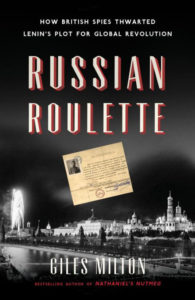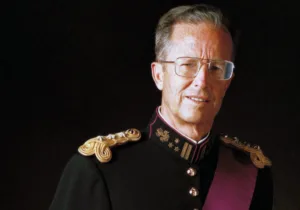Forensic evidence concluding that the fatal wound came from a British-made revolver may not have been enough evidence to convict Oswald Rayner for Rasputin’s murder in 1916, but the British spy would admit before his death that he was at the palace when the murder occurred. The Oxford graduate had studied with the main assassin, Felix Yusupov, before being stationed in Russia alongside a multitude of other British agents helping Britain’s then-ally in their war against Germany. However, as Russia tipped towards Marxist-inspired revolution determined to “liberate” the proletariat from capitalists, these Brits found that their once-partners had become their enemies. In Russian Roulette: How British Spies Thwarted Lenin’s Plot for Global Revolution, Giles Milton retells this captivating history in easy prose that makes for perfect reading in a history-lover’s summer beach-chair, preferably with a glass of Pimm’s as a Union Jack flaps nearby.
While political tensions tear at the threads of the United Kingdom after the close Brexit vote last month,  this very British book reminds the reader of when the kingdom was more united—a time when the exploits of empire moved England and Scotland closer into a single nation and before awkward questions were asked about how well Scotland benefited in a union without colonies. Throughout Russian Roulette, the Crown’s spies heroically defend their empire’s interests, including its rule over India. Milton does not consider the morality of British rule over another nation, and this question would have distracted from the book’s narrative. British sovereignty over India is merely there as a fact of life, for better or worse. Yet a Russia antagonistic towards Britain could easily threaten the Raj, which proves central to the book’s plot.
this very British book reminds the reader of when the kingdom was more united—a time when the exploits of empire moved England and Scotland closer into a single nation and before awkward questions were asked about how well Scotland benefited in a union without colonies. Throughout Russian Roulette, the Crown’s spies heroically defend their empire’s interests, including its rule over India. Milton does not consider the morality of British rule over another nation, and this question would have distracted from the book’s narrative. British sovereignty over India is merely there as a fact of life, for better or worse. Yet a Russia antagonistic towards Britain could easily threaten the Raj, which proves central to the book’s plot.
Milton’s research benefited greatly from declassified Indian records of British espionage during this era, even though MI6 still keeps many of their copies classified. His other sources included the detailed memoirs the spies wrote after their time in Russia, though perhaps some of their adventures should be taken with a grain of salt, even if they make for exciting reads. Other declassified documents from MI6 confirm some of their stories. Because of these sources and his research, Russian Roulette can describe the tsar’s collapse and the Bolsheviks’ rise through a unique British lens.
While telling how spies responded to the Bolshevik Revolution, Milton explains how British intelligence went from focusing on foreign militaries to political and economic targets—from operations that monitored troop deployments to those that would eventually infiltrate Stalin’s personal meetings. Meanwhile, the organization that became the Secret Intelligence Service, or MI6, maintained its independence from military oversight. Leading this Secret Service Bureau’s foreign operations from secret locations in London, Sir Mansfield Cumming (known as “the Chief” or “C” in documents at the time) fought off attempts by the War Office to subordinate this new type of seemingly distasteful and ungentlemanly espionage under military command. Using his personal connections in the War Office, Foreign Office, and Admiralty, Cumming played each organization off of each other and guaranteed that MI6 would not have to take orders from any of them.
With their independence from military oversight, Cumming’s numerous spies in Russia developed secret networks of informants, which were plentiful since many of the Russians hated the Bolsheviks, even if they worked for them. Interestingly, because the new Bolsheviks knew the educated classes despised them so much, they hired many illiterates who could not tell if visas were forged or not, so spies could travel more freely. Yet infiltrating a country and gathering information was often much easier than getting that information back to London. After trial and error (i.e., after many were captured and killed), the spies developed a relay system of couriers, instead of having one courier carry a message from Moscow or Petrograd to the border or port. They also learned that typing messages onto linen sewn into coat collars helped prevent the Cheka, or secret police, from uncovering couriers by frisking suspects until secret paper messages rustled in their clothes.
Though there are many fascinating characters in Russian Roulette, perhaps the most sensational is Sidney Reilly, who helped partially inspire James Bond. A promiscuous polyglot who became wealthy selling arms during the First World War, Reilly had a mysterious background because he told different, conflicting stories of his younger years. Similar to James Bond, he was infamous for his charm and sexual escapades. However, his face does not appear nearly attractive enough to explain his appeal to women (in my own opinion), including an actress half his age with whom he stayed in Moscow. His intense hatred for the Bolsheviks drove him to find multiple ways to topple them, and many believe that Reilly thought highly enough of himself that he could replace Lenin as Russia’s leader. This belief drove him to develop a coup plot that nearly toppled the communists. Despite the plot’s failure, Reilly proved to be a masterful spy who could quickly adopt various identities. At one point while the Cheka searched the British Embassy in Moscow for him, he pulled out his forged Cheka identification paperwork and approached one of the agents to ask what they were doing and for whom they were searching. One may, and probably should, doubt some of his stories, but records do indicate that Reilly was able to use his skills to collect a massive trove of intelligence on the Bolsheviks and their operations.
After the Bolsheviks were able to gain enough control over the Russian government, the leaders sought different ways to destroy capitalism and export Marxist revolution globally, especially to British India. Lenin recruited the Indian-born communist Manabendra Nath Roy to lead the invasion with the hope that further rebellion would engulf the colonies. From Soviet-controlled Turkestan, they were able to recruit an army from Persian and Indian defectors along with a large number of Muslims seeking jihad. Yet, as they began their march the short distance to India, their plans fell apart.
While trying to inflame revolution across Britain’s colony, Russia suffered a debilitating economic crisis, and Lenin hoped to rejuvenate the economy with greater international trade. However, as the Soviet representatives began negotiations, the British decided to use intelligence Cumming’s operations had gathered to force the Russians make concessions not on usual economic matters but on disbanding Roy’s army. In a note attached to the proposed trade agreement, the Brits carefully gave evidence that they already knew about the army, the planned invasion, and Russian support for both. Needing trade with Britain more than revolution in India, the Russians disbanded the army. Nearly no one outside the government knew about the impending crisis, and even news about the trade agreement was buried on page eleven in The Times. Nevertheless, war was avoided.
This history about how British spies were able to uncover the plot to invade India demonstrates how good intelligence can help ensure peace, regardless of how one may feel about Britain’s rule in India at the time. Though countless and nameless spies and couriers were killed, Russian Roulette makes a convincing argument that their work helped save many more who would have died in an unnecessary war.
—
Mark Melton is the Deputy Editor for Providence. He earned his Master’s degree in International Relations from the University of St. Andrews and focuses on civil conflict and European politics.
Photo Credit: The Bolshevik by Boris Kustodiev, 1920. Via Wikimedia Commons.







 Sponsor a student for Christianity & National Security 2024
Sponsor a student for Christianity & National Security 2024